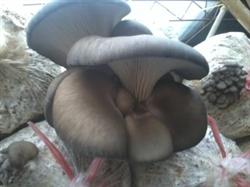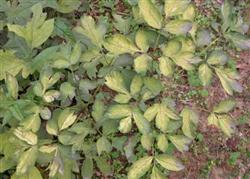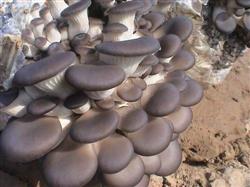Types and prevention of deformities of Pleurotus ostreatus

Abnormal mushroom is a common physiological disease in the production of Pleurotus ostreatus, which seriously affects the yield and quality of Pleurotus ostreatus, and even loses its commercial value completely. This disease is mainly caused by improper management, and a few are caused by strain degradation, variation and virus infection. The main types of deformed mushrooms are as follows: 1. Pleurotus ostreatus has small cap, poor differentiation and long stalk. The reason was that during the period of primordium formation and differentiation, the mushroom room was anoxic, the light was insufficient, and the temperature was high, which affected the normal differentiation and development of the cap. Prevention and treatment methods: strengthen ventilation, adjust light and temperature. 2. The main manifestation of the mushroom cap is that there are many granular protuberances and light color on the edge, the mushroom cover is stiff, the growth is slow, the differentiation of the mushroom cap is poor and the shape is irregular when it is serious, because the development temperature of the mushroom body is too low and lasts for a long time. Resulting in imbalance in the growth of cells in the inner and outer layers. Control methods: adjust the temperature of the mushroom room above the lowest temperature of Pleurotus ostreatus growth, and there is a certain temperature difference to promote the growth, development and differentiation of mushroom body. 3. Cauliflower mushroom image cauliflower, multi-branched, the initial primordium is egg-shaped, inflated, raised, undifferentiated. How branched it is in the later stage. The reason is that before or during mushroom emergence, the mushroom bed or mushroom room was sprayed with high concentration of pesticides, especially "dichlorvos". Young mushrooms are extremely sensitive and most likely to cause this disease. It may also be that mushroom houses contain other harmful gases, such as high carbon dioxide concentration, sulfur dioxide released by burning coal, and so on. Prevention and control methods: the mushroom house should be cautious in the use of pesticides and the concentration should not be too high. Especially during the mushroom period, dichlorvos is absolutely not allowed to be used to strengthen ventilation and discharge harmful gases. 4. The atrophic mushroom body is normal at the initial stage, yellowing, edematous or dry shrinkage in the expansion period, but stops growing, and finally becomes soft and rotten. The reason for edema is that the humidity is too high or more water is sprayed directly on the young mushroom body, which makes the mushroom tissue absorb water, affect respiration and metabolism and stop growing and die. Dry shrinkage is because the air relative humidity is small, the ventilation is too strong, the wind blows directly on the mushroom body, causing Pleurotus ostreatus to lose water and die. Or the medium is malnourished, after forming a large number of primordia, some of them grow rapidly, and the rest stagnate due to insufficient nutrition supply. Prevention and control measures: control humidity between 80,85%, do not spray water on the young mushroom body, do not let the wind blow directly on the mushroom body. Reasonable proportion of culture material composition. A small number of shrunken mushrooms are due to the degeneration of the strain, the symptom is that the cap is not large enough to reverse curl, yellowing and atrophy. Prevention and control methods: select excellent varieties. 5. The primordium of Pleurotus ostreatus is abnormal, loose, multi-branched and shaped like coral. The reason is that when the primordium occurs, there is serious poor ventilation, extremely weak light and lack of nitrogen sources. Prevention and treatment: strengthen ventilation and light to adjust the ratio of carbon and nitrogen, and add nitrogen sources.
- Prev

Diagnosis and treatment of peony yellow leaf disease
In the process of cultivation and management of peony, especially in late spring and early summer, the leaves often turn yellow or even dry charred. There are many reasons why peony leaves turn yellow. first of all, we must find out the reasons in order to prescribe the right medicine to the case. A yellow leaf caused by excessive fertilization. Peony generally uses chicken manure, bean cake, oil residue and other organic fertilizer as topdressing.
- Next

Soil-covering cultivation techniques of Pleurotus ostreatus
In the production of Pleurotus ostreatus, using the soil cultivation technology, the mushroom body is enlarged, the handle is short, the cover is thick, the color is bright, the taste and flavor are good, and the yield can be increased by 30% to 50%. It is a technical innovation in the cultivation of Pleurotus ostreatus. 1. The theoretical basis is the cultivation of Pleurotus ostreatus.
Related
- Fuxing push coffee new agricultural production and marketing class: lack of small-scale processing plants
- Jujube rice field leisure farm deep ploughing Yilan for five years to create a space for organic food and play
- Nongyu Farm-A trial of organic papaya for brave women with advanced technology
- Four points for attention in the prevention and control of diseases and insect pests of edible fungi
- How to add nutrient solution to Edible Fungi
- Is there any good way to control edible fungus mites?
- Open Inoculation Technology of Edible Fungi
- Is there any clever way to use fertilizer for edible fungus in winter?
- What agents are used to kill the pathogens of edible fungi in the mushroom shed?
- Rapid drying of Edible Fungi

